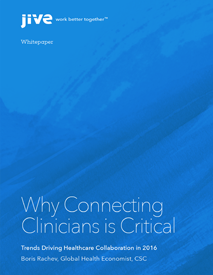There is a lot of talk about the need for more collaboration in healthcare but what does that really mean? Is it more point solutions, like secured texting apps, which are certainly a major step up from pagers but also create yet another communication silo? Gartner Group calls the market category Clinical Communication and Collaboration (CC&C) and covers a number of vendors that run the gamut from secure texting, to emergency communications, to EHR’s like Cerner. I don’t believe effective collaboration can be realized by implementing a group of fractured point solutions. There has to be a clear strategy that covers all aspects of clinical communication and collaboration across the organization.

Successful population health can only be measured with intelligent, real-time analytics that digitally track the patient experience
Let’s look at the challenges around physician communications to illustrate the need for a cohesive approach to CC&C. All health systems have some combination of employee physicians and non-staff physicians who practice at their facilities. Physicians are overwhelmed with email and in the case of non-staff physicians have multiple email accounts, typically one per health system they practice at. Physicians are heavy users of mobile technology, a recent study by Kantar Media noted that 84% of physicians use a smartphone for professional purposes. For this we can draw two conclusions. Email is no longer an effective communication method for physicians—too many email accounts, too much volume. And mobile presents a better opportunity to reach physicians.

A cohesive solution needs to address the fact that email is no longer effective, mobile is pervasive and there is a need for both real-time and asynchronous communications
There are a variety of communication and collaboration needs that physicians have, including:
- Coordinating care with the full care team around a patient
- Receiving news and critical updates
- Receiving emergency alerts
- Consulting with a specialty physician prior to referral
- Collaborating on a committee with colleagues with both staff and non-staff physicians
A cohesive solution needs to address the fact that email is no longer effective, mobile is pervasive and there is a need for both real-time and asynchronous communications. Looking at each of the needs above, it becomes clear that a fully integrated approach is needed.
Coordinating care – Quick responses to questions with real-time messaging is very effective; assuming the full care team has access to the secure messaging platform. Ideally there would also be the ability to capture the conversations around the patient in more of a discussion format. For example: nurse shift change notes. The majority of these conversations are not captured in the EHR but can be helpful in coordinating care for the patient.
Receiving news and critical updates – As noted, email is no longer an effective means of communicating information. What is needed is a centralized way to communicate out to all physicians in the network (both staff and non-staff) to any device (mobile, web, tablet) with full analytics at the content level to understand reach and effectiveness. In addition, the communication should provide the ability for staff to respond back via comments, ratings and likes.
Receiving emergency alerts – In this instance, alerts should be pushed out from a single area using all available channels—email, mobile notifications, texting and web notifications. The key is that the message is driven from a single location where users can go for more detailed information, avoiding cutting and pasting between various point solutions and communication channels.
Consulting with specialist – Consultations between colleagues is typically best facilitated in a discussion type format where the specialist can review the information, ask clarifying questions and provide a recommendation as time permits throughout the day. This is much more effective then either trying to schedule a specific time for the consult or trying using a disruptive approach like secured texting for a non-critical referral.
Collaboration on committees – Not all physicians are involved in various committees and improvement initiatives. For those that are, it is critical that they have an area to collaborate that is simple to use, available on any device, securely accessible outside of the physical confines of the facilities, and fully integrated as a part of the overall CC&C strategy.
What is needed is a fully integrated approach to Clinical Communication and Collaboration, which includes both real-time messaging as well as a integrated secure collaboration platform. This approach will support all the communication and collaboration needs and not create additional communication silos.
GET A PERSONALIZED DEMO
See how Jive works. Request a personalized demo.
See for yourself how Jive can drive productivity and engagement across your organization. Get a free personalized demo.
